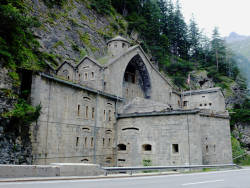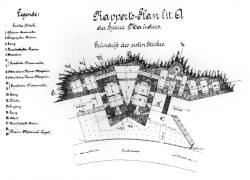Museum Festung Nauders
Useful Information
| Location: |
6543 Nauders.
(46.9131654, 10.4930579) |
| Open: |
JUN to SEP Wed, Sun 15. [2024] |
| Fee: |
Adults EUR 9, Children (6-14) EUR 5, Children (0-5) free. Groups (20+): Adults EUR 7. [2024] |
| Classification: |
 Casemate Casemate
 Cave Castle Cave Castle
|
| Light: |
 Electric Light Electric Light
|
| Dimension: | A=1,202 m asl. |
| Guided tours: | |
| Photography: | allowed |
| Accessibility: | no |
| Bibliography: | |
| Address: |
Museum Festung Nauders, Museumsverein Nauders, Nauders 221, 6543 Nauders.
Karl Ploner, Nauders 183, 6543 Nauders, Tel: +43-5473-86222. E-mail: |
| As far as we know this information was accurate when it was published (see years in brackets), but may have changed since then. Please check rates and details directly with the companies in question if you need more recent info. |
|
History
| 1834 | begin of construction. |
| 1840 | fortress completed. |
Description


The Festung Nauders (Nauders Fortress) is the only completely preserved fortress building in Austria in its original state. It was built between 1834 and 1840 under Emperor Franz I and Ferdinand I. The architect was Franz von Scholl. The fortress comprises 70 rooms on 5 floors, some of which were built up to 20 metres deep into the mountain. A massive granite spiral staircase provides the only access to upper the three floors, each of which could be supplied and defended separately. On the ground floor there are four large gun casemates and numerous ready and storage rooms. A lift shaft with a manual cable winch made it possible to transport bulky goods to the upper floors. The biggest room is located on the fourth floor, a huge chamber with a barrel vault. This chamber has a rather weird architecture, as the excavation from the rock is much bigger. As a result there is a gap between the wall of the chamber and the rock face. The outside of the wall is covered by sheet brass, and it’s possible to walk through this gap. A reason for this strange structure is not given.
The building contains a military museum, the car park on the opposite side of the road has an open air museum with tanks from the World Wars. It is called Panzermuseum Festung Nauders (Nauders Fortress Tank Museum) or Panzergarten (Tank Garden). The Military museum shows weapons, uniforms, equipment and vehicles. There is also an exhibition of the Nauders Model Club.
The fortress was erected to fortify the Finstermünzpass, the road B180 which follows the Stiller Bach, a tributary of the Inn, reaches a height of 1,186 m asl. It’s not a real pass, it’s more like a "half"-pass, as the road soon continues to climb, to finally reach the Reschenpass at 1,507 m asl. Nevertheless, the steep ascent to the fortress and the narrow gorge were of great importance for the fortress. It is the reason why it is also known as Straßensperre Nauders (Road Closure Nauders) or Sperrfort Nauders. It was still in use and of importance during World War I, and it was the oldest manned fortification on the Austrian side. However, there was never a siege at this fortress and so it is in a very good shape.
The building was constructed from masonry and is thus not bombproof. But the parts which were built into the rock were considered absolutely bombproof. Direct bombardment would not have been possible, and indirect fire from howitzers from the road over the rocky outcrops is quite unlikely. The masonry is the reason why this building actually looks more like a cave church than a fortress. The fortress was able to block the road for enemies from both directions. Nevertheless, it was actually constructed to protect the Inn Valley from possible troop invasions from Lombardy or the Engadine across Reschenpass.
- See also
 Search DuckDuckGo for "Museum Festung Nauders"
Search DuckDuckGo for "Museum Festung Nauders" Google Earth Placemark
Google Earth Placemark OpenStreetMap
OpenStreetMap Straßensperre Nauders - Wikipedia (visited: 27-SEP-2024)
Straßensperre Nauders - Wikipedia (visited: 27-SEP-2024) Museum Festung Nauders
Museum Festung Nauders  (visited: 27-SEP-2024)
(visited: 27-SEP-2024) Festung Nauders
Festung Nauders  (visited: 27-SEP-2024)
(visited: 27-SEP-2024) Festung Nauders
Festung Nauders  (visited: 27-SEP-2024)
(visited: 27-SEP-2024) FESTUNG NAUDERS
FESTUNG NAUDERS  (visited: 27-SEP-2024)
(visited: 27-SEP-2024)
 Index
Index Topics
Topics Hierarchical
Hierarchical Countries
Countries Maps
Maps